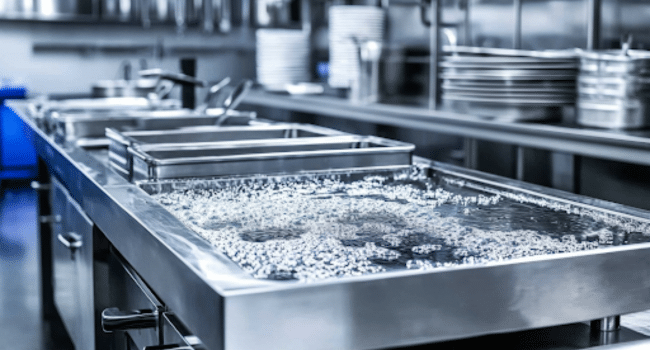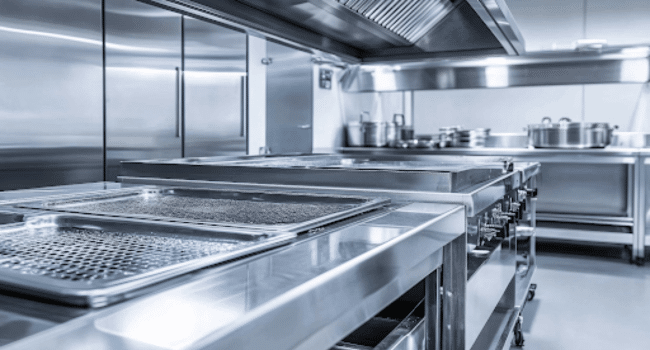Table of Contents
A grease trap is one of the most overlooked yet essential components in a commercial kitchen. It works silently in the background, capturing fats, oils, and grease (FOG) before they enter the plumbing system. Without it, kitchens would face constant blockages, foul odors, and serious sanitation risks.
However, installing a grease trap isn’t enough—it needs consistent upkeep to do its job effectively. Poor maintenance can lead to health code violations, plumbing emergencies, and even temporary shutdowns. Understanding how to manage your grease trap is a basic responsibility for any kitchen operator, not an optional task.
Read on to find out what every commercial kitchen should know to keep its grease trap working properly and avoid preventable problems.
Why Grease Trap Maintenance Matters
A properly maintained grease trap keeps your kitchen efficient, compliant, and free from costly disruptions. Letting it fall into neglect can lead to serious issues that affect daily operations and long-term expenses.
The following are three key reasons to prioritize regular maintenance:
- Protects your plumbing system from early damage: When fats, oils, and grease build up, they solidify and clog drain lines. This forces wastewater to back up into sinks or floors, which can slow down service and damage equipment. Staying ahead of these issues helps reduce repair costs and keep plumbing systems in better condition over time.
- Keeps your kitchen safer and more sanitary: Traps that aren’t cleaned regularly can start to emit strong odors and attract pests. Grease and food waste left sitting for too long become a hygiene risk, especially in hot environments. Regular maintenance helps control smells and supports a cleaner work area for staff.
- Improves reliability through expert servicing: Many kitchen operators partner with a plumbing company that specializes in commercial and retail plumbing services, such as Superior Plumbing or another trusted provider. These professionals offer scheduled service, proper waste disposal, and inspections that help you avoid surprise issues. With the right support in place, maintenance becomes consistent and less of a burden for your team.
Grease trap upkeep may seem routine, but when done right, it prevents serious problems and supports smoother kitchen operations.
Steps for Proper Grease Trap Cleaning
Cleaning a grease trap isn’t complicated, but skipping important steps can create bigger problems down the line. Whether handled in-house or by a contractor, the process should be thorough and consistent.
Below are three key steps that play a critical role in effective grease trap maintenance:
- Open the lid safely and inspect the contents: Use the correct tools and wear protective gear, especially gloves and eye protection. Grease traps can contain gases or sharp debris, so opening them with care is essential. A visual inspection helps you gauge how full the trap is and identify anything unusual, like broken parts or improper grease breakdown.
- Remove waste completely, including grease and solids: Skimming the top isn’t enough. Use a scoop or vacuum pump to remove the floating grease, settled solids, and wastewater. Make sure all compartments are emptied—leaving behind sludge can cause odors and reduce trap efficiency quickly after cleaning.
- Scrub and rinse all internal components thoroughly: After removal, the trap’s walls, baffles, and lid should be scrubbed with a wire brush or scraper. Degreasing solutions help lift residue that might affect future flow. Rinse all cleaned parts to remove loosened debris before reassembling the unit.
When done properly, this routine supports smoother kitchen operations and extends the life of the trap between services.

How Often Should You Clean Your Grease Trap?
Establishing the right cleaning schedule depends on the volume and type of waste produced in your kitchen. A busy commercial kitchen that handles a lot of frying or uses heavy oils will fill up faster than one that does lighter food prep. Over time, excess buildup can block floor drains, affect your plumbing system, and increase the risk of foul odors circulating in food prep areas.
In addition to the amount of grease, the type of trap installed also plays a role. Gravity grease interceptors and hydromechanical grease interceptors may have different maintenance intervals, and failing to follow the manufacturer’s guidelines can result in overflow or premature wear. Also, regular monitoring helps prevent slow drains, which are often an early sign that your grease trap cleaning is overdue.
Choosing a Professional Grease Trap Service
Working with the right service provider can help you avoid unexpected issues that come from improper cleaning or poor disposal practices. Instead of relying on general cleaning crews, look for specialists who focus on grease trap systems and understand how they function in a high-demand kitchen setting. These professionals bring the tools and techniques needed to clean thoroughly without disrupting your workflow.
Beyond technical skills, strong communication and transparency matter. A reliable company will walk you through their process, explain what to expect after each visit, and notify you of potential concerns before they become costly repairs. This ongoing collaboration helps you maintain control over your kitchen operations while ensuring grease trap upkeep stays consistent and predictable.
Final Thoughts
Staying on top of grease trap maintenance is non-negotiable for any commercial kitchen. It protects your plumbing, ensures compliance, and keeps your operation running efficiently.
Whether you’re cleaning in-house or hiring experts, consistency is key. Set a schedule, document every service, and act on warning signs early. It’s a small investment of time that saves you from big problems down the line.
